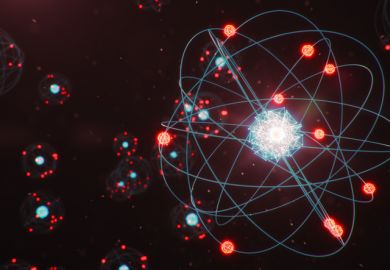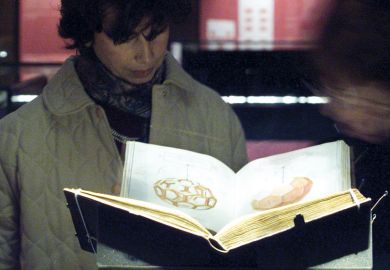The most recent James Bond movie informed us that "The world is not enough". Now Sir Martin Rees, writing about cosmology for a general audience, informs us that the universe is not enough, either. The astronomer royal is one of the world's most distinguished cosmologists, and his own research has contributed to many of the topics that he so ably describes. His book, Just Six Numbers , is a valuable addition to the Science Masters series.
Cosmology has shifted in recent years from speculation to detailed investigation. The cosmologist Dennis Sciama once said that cosmology was based on one fact: that the universe is expanding. When, in 1965, Arno Penzias and Robert Wilson discovered the radio whisper from the big bang that we call the primordial background radiation, Sciama admitted that a second cosmological fact was now known. Subsequently, the discovery that deuterium (heavy hydrogen) and other light elements have abundances that match the theory that they were formed in the first thousand seconds or so of time has provided a third basic cosmological fact. As the facts accumulate, cosmological theory has become more scientific.
So which six numbers does Rees choose to illustrate our current understanding of the universe? Surprisingly, none of them is the Hubble constant - the rate at which the universe is expanding and which has been and continues to be the subject of such controversy - in spite of the Hubble Space Telescope's concentrating on its determination. The first number is the relation between the forces of gravity and electromagnetism. This is a large number: 1,000, 000,000,000,000,000,000,000,000,000,000, 000 (a 1 with 36 zeroes after it). If that number were much smaller or larger, our habitable universe would not have existed and we would not be here because large-scale, long-lived features would not have been formed.
The second number is 0.007, but not because we are back to Bond. That number is the efficiency at which nuclear fusion releases energy. In particular, 0.007 (that is, 0.7 per cent) of the mass of each set of four hydrogens that fuse into helium at the Sun's core is converted into energy, following Einstein's formula that energy equals mass times the speed of light squared. Rees describes how the roster of elements would be different, and how we could not have our carbon-based biosphere, if that number were 0.006 or 0.008.
The third number, which does deal with the expansion of the universe, is Omega, the ratio of the actual density of the universe to the critical density that divides a perpetually expanding universe from one that will eventually contract. Our measurements find an Omega that is much smaller than 1, and astronomers have been finding signs of "dark matter", matter that does not shine in any part of the electromagnetic spectrum, perhaps filling the gap. Rees explains how dark matter can be detected by how strongly it makes light rays deviate. "Indeed, the deflection of starlight by the Sun's gravity, observed by Eddington and others during the 1919 total eclipse, famously offered an early test of relativity that propelled Einstein to worldwide celebrity."
The fourth number again goes back to Einstein. It is his "cosmological constant", a term he introduced to counteract the tendencies of the universe in his equations to expand or contract rather than remaining stable. When Hubble discovered early in the last century that the galaxies were increasingly red-shifted at greater distances, which was interpreted by others as an expansion of the universe, Einstein withdrew the extra term from his equation. But in the past two years, we have increasing evidence from the study of distant supernovae that the universe may be expanding at an accelerating rate rather than slowing because of accumulated gravity. A cosmological constant could provide a type of anti-gravity force to explain those observations, and so has gained new respectability.
The fifth number has to do with the ripples in space that turned up in the detailed observations of the primordial background radiation mapped by the Cosmic Background Explorer spacecraft a decade ago, and since mapped in more detail for small areas of the sky with radio telescopes on Earth. The universe seems smooth to a ratio of 1:100,000, and in a stone "you'd be... perplexed by the overall smoothness". Two spacecraft, Nasa's Microwave Anisotropy Probe and the European Space Agency's Planck/Surveyor (an unfortunate cost-saving combination of two once-separate valuable spacecraft), are to be launched in the next few years to provide greatly detailed mapping of the ripples, which is expected to pin down a wide variety of cosmological theory.
Finally, the book's sixth number is the dimensionality of space-time. We have been used, since Einstein's general theory of relativity, to a four-dimensional space-time, but the "superstring theory" under investigation by elementary-particle physicists that promises to be a theory of everything actually functions best in a 10-dimensional or 11-dimensional space, though six of those dimensions are curled up so small that we do not sense them - the way a garden hose seen across a lawn may look like a one-dimensional line until we get up close to it.
These six numbers are used as a framework to describe cosmology, often with felicitous wording. It is good to know that the new ideas have raised the author's confidence in the big bang theory from 90 per cent a decade or so ago to 99 per cent now.
But how does he interpret the "tuning" that these six numbers seem to imply, since if any of them were very different we would not have a universe anything like our own? "If you imagine setting up a universe by adjusting six dials, then the tuning must be precise in order to yield a universe that could harbour life," Rees writes. He concludes "that the apparent 'tuning' intimates" the remarkable conclusion "that our observable universe - all we can see out to the limits of our telescopes - is just one part of an ensemble, among which there is even a diversity of physical laws". He prefers to think of each member of this ensemble as a "universe" - "each one maybe starting with its own big bang" - and reserve the idea of a "multiverse" for the whole.
Jay M. Pasachoff is professor of astronomy, Williams College, Massachusetts, United States.
Just Six Numbers: The Deep Forces that Shape the Universe
Author - Martin Rees
ISBN - 0 297 84 297 8
Publisher - Weidenfeld and Nicolson
Price - £12.99
Pages - 173



